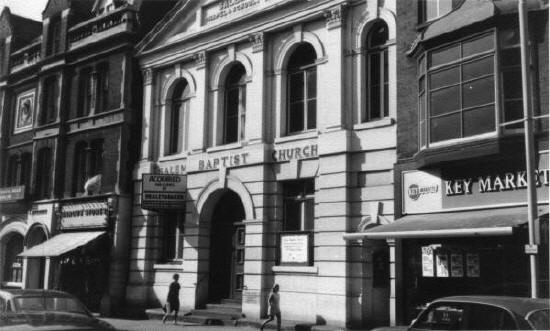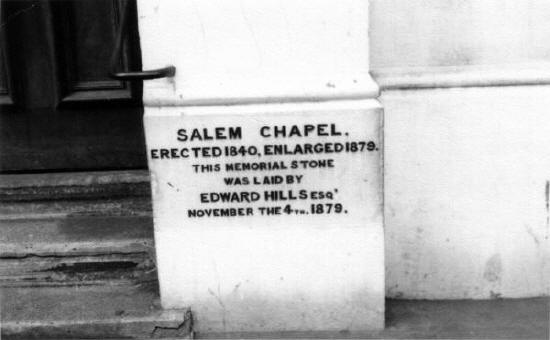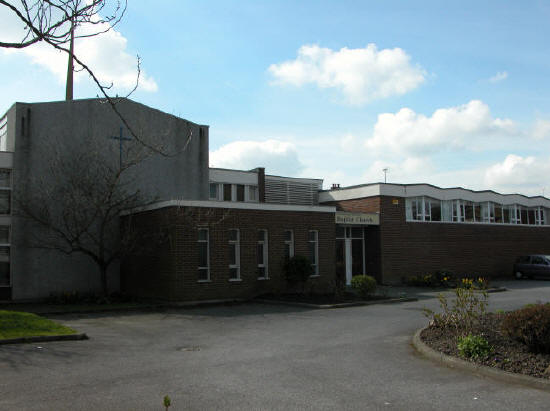Salem Chapel and the Dover Baptists |
|
|
|
|
There have certainly been Baptists in Dover since 1643.
|
|
|
But Holyoak suggests that there may, in fact, have been Baptists in Dover since Roman times.
One well-known Dover Baptist was Captain Samuel Taverner. Born in 1621, he was made Captain of a Troop of Horse at the age of 22, and later received a commission from Cromwell, which he resigned after the Restoration. Taverner had a grocer's shop in Market Lane, which he kept until his death. During his term as Governor of Deal Castle, he heard Edward Prescott preaching in a field, and concealed himself behind a hedge to listen. Despite having previously opposed the sect, Taverner was so impressed that he subsequently became a stalwart supporter. In 1670, he was brought before the Privy Council, along with five other prominent Dover men, and reprimanded for attending conventicles. Dover Corporation was commanded to seal up all such places, but Taverner would not submit to the Privy Council's orders and was imprisoned in the castle. In 1681 he was ordained as Pastor of the Dover Baptist Church. In 1692 he secured official permission to use the south end of his house near Market Lane for purposes of public worship. He also set aside part of his garden for use as a graveyard; this was later incorporated into the Old St. Mary's Burial Ground (formerly St. Martin le Grand) and his tomb could still be seen there before the area was excavated for a new road in the 1970s. The inscription read:
His second wife Susanna and his eldest son, a "chyrurgion" (surgeon) were buried with him. On the wall near to his tomb was another epitaph, which described him as:
The congregation continued to worship in what had been part of Taverner's house for some time after his death, until, during the pastorate of Robert Pyall (c.1750) a bequest of £70 was used to purchase a site for a purpose-built chapel nearby. A new chapel was built in Adrian Street in 1820. At around the same time the General Baptists were opening their new Chapel, £60 was put up to start a Particular Baptist Church, and a former chemist's shop in Snargate Street was rented and fitted out for public worship. In 1823 the foundation stone was laid for the Pentside Baptist Chapel. This church was to move to the Queen Street Chapel, which had been vacated by the Congregationalists, in the early 1900s. It finally closed in July 1909. Salem Church was constituted in 1839, by dissatisfied members of the Pentside Chapel. The first services were held in March of that year in Mr. William Corbett's school room, on the corner of Union Row and Military Road. They started a Sunday school and set about making plans to build a new church. The foundation stone of the new church, in Biggin Street, was laid by the Treasurer, Mr. Alfred Kingsford on 20th April 1840, who generously wrote off £800 of the debt of £1,800 remaining on the property five years after its opening. In 1873 another Baptist Church was formed, which initially held Sunday services and a Sunday school in the Wellington Hall, with week-night services in the Gospel Hall, at the rear of a house in York Street.. They later moved to a new building, known as the Dover Tabernacle, in Priory Road. This building later passed into the hands of the Salvation Army, who in turn sold it to H.M. Postmaster General, after which it was demolished in 1913 to make way for the new Post Office. |
|
|
|
|
|
|
The Salem Chapel stood where Boots the Chemist now stands in Biggin Street. It moved to new premises in Maison Dieu Road, just to the north of the junction with Park Street, in 1969. The picture above was taken in 1970, when the premises had been "acquired for clients" by Healey & Baker. Also acquired shortly afterwards were Marcus' Stores and the Queen's Arms, all of which were demolished to make way for the new Boots store.
This is the new Salem, opened in 1969, in Maison Dieu Road between Park Street and Crafford Street. |
|
A full history of the Salem Baptist Church can be found in Godden (2001) The family history of Captain Samuel Taverner can be found here |
|


